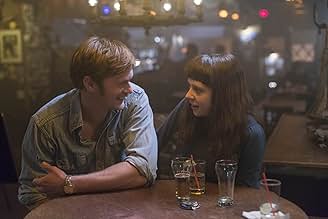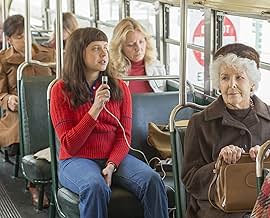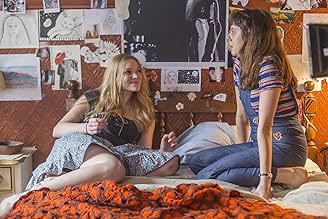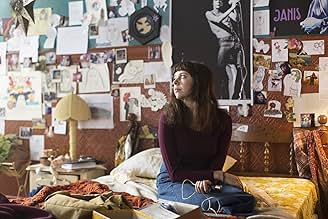VALUTAZIONE IMDb
6,8/10
34.690
LA TUA VALUTAZIONE
Un'artista adolescente che vive nella San Francisco degli anni '70 ha una relazione con il fidanzato di sua madre.Un'artista adolescente che vive nella San Francisco degli anni '70 ha una relazione con il fidanzato di sua madre.Un'artista adolescente che vive nella San Francisco degli anni '70 ha una relazione con il fidanzato di sua madre.
- Regia
- Sceneggiatura
- Star
- Premi
- 16 vittorie e 37 candidature totali
Susannah Rogers
- Voice of Aline Kominsky
- (voce)
- (as Susannah Schulman)
Recensioni in evidenza
"The Diary of a Teenage Girl" is a film that shouldn't be as uncommon as it is for American cinema. It's a seriously contemplative and revealing drama about a young woman lost and confused about her sexual identity upon committing one of society's most serious taboos and realizing that she liked it and might want to try it again. And again. And enough times to keep an audio diary of her thoughts and experiences about said act.
I'll catch you up; set in 1970's San Francisco, Minnie (Bel Powley), a fifteen-year-old girl and aspiring cartoonist, experiences her sexual awakening after losing her virginity to her mother's sorta-boyfriend Monroe (Alexander Skarsgård). Minnie considers herself overweight and undesirable in every sense, and is largely neglected by her Bohemian mother Charlotte (Kristen Wiig), who is usually too busy smoking weed or doing drugs with strangers to even notice her daughter, so this awakening comes as an immense shock to Minnie and her person.
Minnie begins to crave more sex and attention from Monroe, going as far as to make intimate sex with him a regular thing, in addition to craving sex from strangers and other boys her age, all under her mother's nose. This sex drive, however, is deeper than horniness, but a cry by Minnie for companionship, desire, and, most of all, love. Minnie wants to be the apple of someone's eye, so much so that when she leaves, the person feels like they'll die without her company and security.
I've long had the same hunger Minnie has had, though I've been fortunate, as a male, to see roughly two or three coming of age films that accurately reflect my emotions, my desires, and my sexual awakening. Young girls and stories of their sexual awakening have been cruelly shortchanged in American film and "The Diary of a Teenage Girl" takes note of that just by existing. Consider scenes when Monroe and Minnie have sex, makeout with one another, or Minnie describes past sexual advances to her best friend. If these scenes made you at all uncomfortable, uneasy, or awkward (like they did me), then writer and directress Marielle Heller has effectively proved that fact without even saying it. Now switch the genders of the two main characters, think about the situation over again, and see if you feel that same level of discomfort.
Heller unapologetically details Minnie's desires in a way that, while revealing, is whimsical, thanks to the presence of Minnie's drawings springing to life before her eyes. However, this occasional distraction is offset by Heller's honest depiction of Minnie and, most importantly, the rawer scenes of the film, like when we see Minnie stand naked before a mirror as she examines her body and voices her desire to be loved and cherished. It's something I'm sure most young girls have done at least a few times in their life; standing before a mirror entirely exposed and hoping someone will love you for all of you rather than just parts of you. It's the basic level of human feeling, and Minnie has discovered it and craves it much quicker than any of her friends have.
Bel Powley is a force on-screen here, positioning herself not as a fabled caricature but an empowering everygirl that transcends beyond the confines of a typical teenage girl into somebody many can relate to. It also helps that Powley, herself, is such a great screen presence, confident even when her character is insecure, and encapsulated in a bubble that teeters between innocence and the loss of innocence.
"The Diary of a Teenage Girl" could easily be paired with "Turn Me On, Goddammit!," a Norwegian coming of age drama about a girl relatively the same age as Minnie, who becomes entranced with masturbation and sexual pleasure so much so that it takes over her life. Truly impacting and significant coming of age stories for young girls are depressingly few and far between and here is a film that boldly asserts itself by silently calling audiences out on its double standards for young women, focusing on a relatable protagonist throughout the film, giving us artful direction and attractive aesthetics not as a means to sugarcoat but to humanize, and concluding the picture with an ending that, while unfortunately fairly radical for American cinema, hits as hard as some of the best endings of films this year.
I'll catch you up; set in 1970's San Francisco, Minnie (Bel Powley), a fifteen-year-old girl and aspiring cartoonist, experiences her sexual awakening after losing her virginity to her mother's sorta-boyfriend Monroe (Alexander Skarsgård). Minnie considers herself overweight and undesirable in every sense, and is largely neglected by her Bohemian mother Charlotte (Kristen Wiig), who is usually too busy smoking weed or doing drugs with strangers to even notice her daughter, so this awakening comes as an immense shock to Minnie and her person.
Minnie begins to crave more sex and attention from Monroe, going as far as to make intimate sex with him a regular thing, in addition to craving sex from strangers and other boys her age, all under her mother's nose. This sex drive, however, is deeper than horniness, but a cry by Minnie for companionship, desire, and, most of all, love. Minnie wants to be the apple of someone's eye, so much so that when she leaves, the person feels like they'll die without her company and security.
I've long had the same hunger Minnie has had, though I've been fortunate, as a male, to see roughly two or three coming of age films that accurately reflect my emotions, my desires, and my sexual awakening. Young girls and stories of their sexual awakening have been cruelly shortchanged in American film and "The Diary of a Teenage Girl" takes note of that just by existing. Consider scenes when Monroe and Minnie have sex, makeout with one another, or Minnie describes past sexual advances to her best friend. If these scenes made you at all uncomfortable, uneasy, or awkward (like they did me), then writer and directress Marielle Heller has effectively proved that fact without even saying it. Now switch the genders of the two main characters, think about the situation over again, and see if you feel that same level of discomfort.
Heller unapologetically details Minnie's desires in a way that, while revealing, is whimsical, thanks to the presence of Minnie's drawings springing to life before her eyes. However, this occasional distraction is offset by Heller's honest depiction of Minnie and, most importantly, the rawer scenes of the film, like when we see Minnie stand naked before a mirror as she examines her body and voices her desire to be loved and cherished. It's something I'm sure most young girls have done at least a few times in their life; standing before a mirror entirely exposed and hoping someone will love you for all of you rather than just parts of you. It's the basic level of human feeling, and Minnie has discovered it and craves it much quicker than any of her friends have.
Bel Powley is a force on-screen here, positioning herself not as a fabled caricature but an empowering everygirl that transcends beyond the confines of a typical teenage girl into somebody many can relate to. It also helps that Powley, herself, is such a great screen presence, confident even when her character is insecure, and encapsulated in a bubble that teeters between innocence and the loss of innocence.
"The Diary of a Teenage Girl" could easily be paired with "Turn Me On, Goddammit!," a Norwegian coming of age drama about a girl relatively the same age as Minnie, who becomes entranced with masturbation and sexual pleasure so much so that it takes over her life. Truly impacting and significant coming of age stories for young girls are depressingly few and far between and here is a film that boldly asserts itself by silently calling audiences out on its double standards for young women, focusing on a relatable protagonist throughout the film, giving us artful direction and attractive aesthetics not as a means to sugarcoat but to humanize, and concluding the picture with an ending that, while unfortunately fairly radical for American cinema, hits as hard as some of the best endings of films this year.
Been hopelessly hooked, for the past several days now, to the captivating selection of 1970s pop that forms the music soundtrack of The Diary of a Teenage Girl.
The film itself, about a teenage girl discovering and embracing sex amidst the Bohemian surroundings of 1970s San Francisco, impressed me for its rare honesty, its vibrancy, and the wonderful music soundtrack that accompanies the film's moods. Phoebe Gloeckner's searing and much acclaimed 2002 graphic novel comes to screen with a careful selection of eclectic tracks from the 1960s-70s that make the film soar at times. The film is not for the prudish and easily shocked though. And that includes the nannies at the Academy who have completely shut out this indie from this years Oscar nominations!
The film itself, about a teenage girl discovering and embracing sex amidst the Bohemian surroundings of 1970s San Francisco, impressed me for its rare honesty, its vibrancy, and the wonderful music soundtrack that accompanies the film's moods. Phoebe Gloeckner's searing and much acclaimed 2002 graphic novel comes to screen with a careful selection of eclectic tracks from the 1960s-70s that make the film soar at times. The film is not for the prudish and easily shocked though. And that includes the nannies at the Academy who have completely shut out this indie from this years Oscar nominations!
This movie follows a teenage girl's sexual awakening, which involves statutory rape, prostitution, drugs, and other things that weren't a part of my far more vanilla teenagehood. The main character, Minnie, is creative and bright but also has the delusional mind of a teenager and a bit more of the "I'll try anything once" attitude that might be good for her.
The movie itself doesn't seem to judge anyone. Not the mother who does coke with her daughter or the boyfriend she seduces or Minnie herself. The life they lead seems appropriate for an appearance on the Jerry Springer Show, yet she never portrays them as mouth-breathing idiots but more as just reasonably decent people with dubious judgment. It's surprising, particularly at a time when the movie idea of the girl and the older man has moved from romantic to creepy, to see this straightforward portrayal.
It's also cleverly filmed and includes some nice animated sequences. I'd definitely recommend it.
The movie itself doesn't seem to judge anyone. Not the mother who does coke with her daughter or the boyfriend she seduces or Minnie herself. The life they lead seems appropriate for an appearance on the Jerry Springer Show, yet she never portrays them as mouth-breathing idiots but more as just reasonably decent people with dubious judgment. It's surprising, particularly at a time when the movie idea of the girl and the older man has moved from romantic to creepy, to see this straightforward portrayal.
It's also cleverly filmed and includes some nice animated sequences. I'd definitely recommend it.
Being a grumpy old guy, I'm not at all the target audience for this film, so please bear that in mind when I tell you that I found this a fairly tedious coming-of-age movie. I admired aspects of it - in particular the performances of Bel Powley and Alexander Skarsgård - but I wasn't able to maintain my interest in the story.
The biggest obstacle was, I think, that Minnie, the eponymous teenage girl, was not the only adolescent around. All the adults in her life were at various stages of arrested development. This is possibly the point both of the movie and of the novel it is based on: how can a child grow up when all her role-models are children themselves? It's an interesting question, but when transmitted as drama the audience finds itself stuck in high school for the duration.
The biggest obstacle was, I think, that Minnie, the eponymous teenage girl, was not the only adolescent around. All the adults in her life were at various stages of arrested development. This is possibly the point both of the movie and of the novel it is based on: how can a child grow up when all her role-models are children themselves? It's an interesting question, but when transmitted as drama the audience finds itself stuck in high school for the duration.
In many ways a period piece, this indie film captures a very special time period in San Francisco, a time when counterculture flourished and withered, people experimented and abused all kinds of substances, and teen artist Minnie experiences a lot of firsts, in the eternal search for acceptance, love, and a sense of purpose.
In spite of a brave, earnest, and raw performance by a deliberately exposed Bel Powley, very believable as a teenager in the aforementioned period, and of a subtle, nuanced and understatedly magnetic one by the great Alexander Skarsgård, this movie falls short because its characters are sadly just a bit too immature, selfish, and unlikable.
While that sounds very much like the typical description of the stereotypical youth, it remains nonetheless a major fault in the script how unsympathetic Minnie is throughout, with no real point of self-reflection or regrets over some of her actions, refusing to deal with the consequences of even her more heinous ones.
Surrounded by egotistical, likewise emotionally stunted, at times manipulative adults, it may be no wonder that the main character is unable to learn or grow much, but the level of navel-gazing is still a bit too grating, with the protagonist of this clearly autobiographical story experiencing life events without any sort of moral compass whatsoever.
The film drags towards the end, perhaps because of the fragmented, increasingly hazy way the story is told as the movie progresses, but also because by then we care very little about the fate of the different characters. Though this intimate film does hit some high notes in terms of mood, acting, and cinematography, the end result is unsatisfying.
(+) The reconstruction of 70's San Francisco is very well done. Some of the scenes really hit the point. Mood and color palette also well done.
(-) Unsympathetic characters, starting with the amoral, self- centered protagonist, doom the movie.
In spite of a brave, earnest, and raw performance by a deliberately exposed Bel Powley, very believable as a teenager in the aforementioned period, and of a subtle, nuanced and understatedly magnetic one by the great Alexander Skarsgård, this movie falls short because its characters are sadly just a bit too immature, selfish, and unlikable.
While that sounds very much like the typical description of the stereotypical youth, it remains nonetheless a major fault in the script how unsympathetic Minnie is throughout, with no real point of self-reflection or regrets over some of her actions, refusing to deal with the consequences of even her more heinous ones.
Surrounded by egotistical, likewise emotionally stunted, at times manipulative adults, it may be no wonder that the main character is unable to learn or grow much, but the level of navel-gazing is still a bit too grating, with the protagonist of this clearly autobiographical story experiencing life events without any sort of moral compass whatsoever.
The film drags towards the end, perhaps because of the fragmented, increasingly hazy way the story is told as the movie progresses, but also because by then we care very little about the fate of the different characters. Though this intimate film does hit some high notes in terms of mood, acting, and cinematography, the end result is unsatisfying.
(+) The reconstruction of 70's San Francisco is very well done. Some of the scenes really hit the point. Mood and color palette also well done.
(-) Unsympathetic characters, starting with the amoral, self- centered protagonist, doom the movie.
Lo sapevi?
- QuizThe classroom scenes were shot at Lincoln Middle School in Alameda, CA. Although the film crew was given permission to shoot in the school, the school staff objected to the content of the script and insisted no filming be done at any time when students could possibly be on campus. As such, the classroom scenes were shot on a single night, with lights outside the windows to give the appearance of daytime.
- Curiosità sui creditiJoint Roller Lindsay Hannon
- ConnessioniFeatured in The Tonight Show Starring Jimmy Fallon: Chris Meloni/Luke Bryan (2015)
- Colonne sonoreLooking for the Magic
Written by Dwight Twilley
Performed by Dwight Twilley Band
Courtesy of Capitol Records under license from Universal Music Enterprises
I più visti
Accedi per valutare e creare un elenco di titoli salvati per ottenere consigli personalizzati
- How long is The Diary of a Teenage Girl?Powered by Alexa
- What is the significance of the Patty Hearst trials?
- What narration device is used in 'The Diary of a Teenage Girl'?
Dettagli
- Data di uscita
- Paese di origine
- Sito ufficiale
- Lingua
- Celebre anche come
- Diario de una chica adolescente
- Luoghi delle riprese
- Aziende produttrici
- Vedi altri crediti dell’azienda su IMDbPro
Botteghino
- Budget
- 2.000.000 USD (previsto)
- Lordo Stati Uniti e Canada
- 1.477.002 USD
- Fine settimana di apertura Stati Uniti e Canada
- 52.334 USD
- 9 ago 2015
- Lordo in tutto il mondo
- 1.775.133 USD
- Tempo di esecuzione1 ora 42 minuti
- Colore
- Mix di suoni
- Proporzioni
- 2.35 : 1
Contribuisci a questa pagina
Suggerisci una modifica o aggiungi i contenuti mancanti

Divario superiore
What is the streaming release date of Diario di una teenager (2015) in Australia?
Rispondi





































